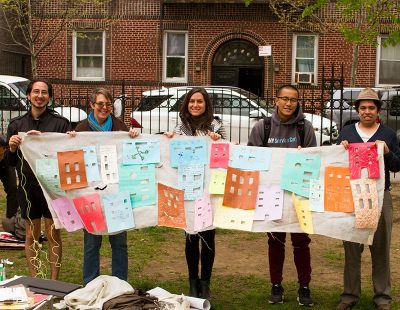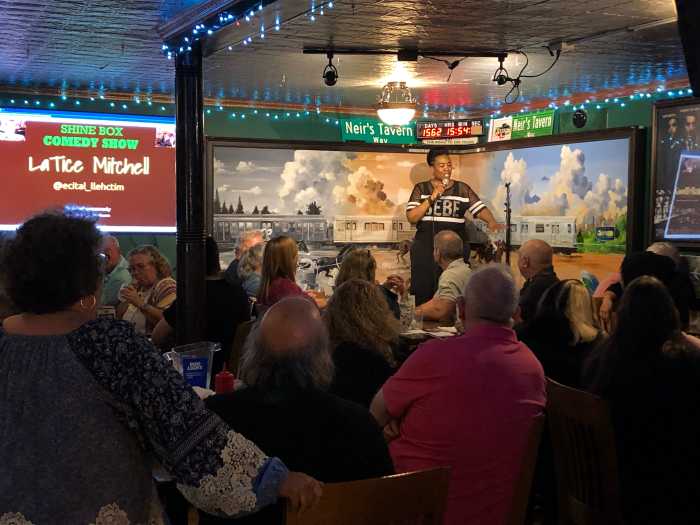
Workshop April 30, 2017 (Photo: Renee Sing)
Jan. 5, 2018 By Tara Law
Storytellers from Jackson Heights, Corona and Elmhurst will gather on Jan. 27 for an evening of music, poetry, art and stories.
The event, called “Almost Home/Casi Llegando a Casa,” will feature five local artists who will tell stories, recite poetry and perform music that address topics such as gentrification, displacement, immigration and housing justice.
Attendees are invited to the floor to share their stories about these issues after the featured artists perform.
The event will take place from 6 p.m. to 8:30 at D’antigua tapas bar and restaurant, located at 84-16 Northern Blvd. Attendance is free.
Pop-up artwork will on display, including an installation of “Fragile City” by artist Priscilla Stadler. The work is a model city with buildings created from cheesecloth.
Attendees are also invited to participate in the “City of Stories” art project. Participants are encouraged to write their own stories on paper houses, which are hung up together to create a city.
The night is the final event of “Almost Home/Casi Llegando a Casa,” a yearlong storytelling workshop project in Jackson Heights, Corona and Elmhurst. Neighborhood residents have gathered throughout the past year to tell stories about different topics relevant to their neighborhoods.
Almost Home was organized by members of the Five Boro Story Project, which conducts storytelling programs across the city.
The group collaborated with The Queens Neighborhoods United, a grassroots activist group, to create the event themes. The Queens Neighborhoods United promotes community control over land-use, policing, and immigration policies.
Bridget Bartolini, founder of the Five Boro Story Project, said that the project’s goal was to foster a sense of community and to consider issues that affect the neighborhood.
“People said it was powerful to hear others’ stories and to share their [own] stories,” said Bartolini. “They saw that they had things in common. It helps us to understand each other and turn strangers into neighbors.”
7 Comments






https://statisticalatlas.com/neighborhood/New-York/New-York/Jackson-Heights/Household-Income
Jackson Heights Household Income is right at the same level as NYC average. This is right smack down in the middle. It is a middle class neighborhood.
Income is not social class.
Depend on which theory you use to define “class”, Marxist, Weberian, or common three-stratum model? There are some like Pierre Bourdieu, who defined and measured class according to the combination of amount and kind of economic, cultural and social resources.
In the US, there are usually four social classes, the upper class, the middle class, the working class and the lower class. The upper class typically earns above $250,000 per year; the middle class earns between $48,000 and $249,000 per year; the working class up to $48,000; and the lower class up generally receives a minimal income that is not enough to sustain themselves.
https://money.usnews.com/money/personal-finance/articles/2012/09/13/where-do-you-fall-in-the-american-economic-class-system
Jackson Heights had a severe decline in the late 60’s and 70’s. It’s not yet returned to the neighborhood it had been. The fight now is to keep it lower class rather than the middle class inclusive neighborhood it was before de-gentrification. This isn’t gentrification now. It’s a return to the solid neighborhood it used to be.
Jackson Heights was initially planned as a place for middle- to upper-middle income workers from Manhattan to raise their families. It was a place where middle class families can excellent housing. It may have morphed at one point, post war, but it is getting back to its roots. How is that gentrification?
https://en.wikipedia.org/wiki/Jackson_Heights,_Queens
Gentrification? What are people talking about? Jackson Heights was built as a luxury neighborhood. The people who orchestrated its down turn are crying because Jackson Heights elegance has been rediscovered. Good riddance.
It’s indeed gentrification because these rising costs are displacing long-time residents. An ‘evolving’ neighborhood should not come at the expense of those who have only known that place as their home.